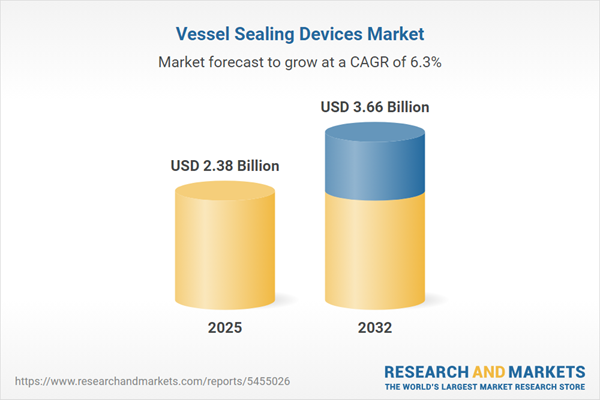Speak directly to the analyst to clarify any post sales queries you may have.
Senior executives evaluating procurement of vessel sealing devices require tailored, actionable insights that clarify market direction, support agile investment decisions, and reveal how emerging technologies shape operational excellence in modern surgical care settings.
Market Snapshot: Vessel Sealing Devices Market Overview
The vessel sealing devices market reached USD 2.24 billion in 2024, propelled by broad adoption of innovative surgical technologies throughout hospitals and specialty centers. Increasing demand for minimally invasive and robotic-assisted procedures is triggering adjustments to purchasing protocols and workflow optimization across clinical environments. Regulatory developments continue to raise the bar for procurement standards, resulting in accelerated integration of hybrid energy platforms and data-driven solutions within operating rooms. Competitive dynamics now emphasize agility, interoperability, and heightened compliance, guiding vendor selection strategies and contributing to sustained industry transformation.
Scope & Segmentation of the Vessel Sealing Devices Market
- Product Types: Advanced bipolar systems are engineered for both handheld and laparoscopic settings, allowing healthcare providers to align device deployment with the precise needs of their surgical cases and operating volumes.
- Monopolar Devices: Available as either single-use or reusable solutions, these devices provide flexibility in managing procurement budgets, while facilitating sustainability initiatives and aligning with clinical objectives.
- Ultrasonic Platforms: Designed for high-precision tissue sealing, ultrasonic systems support the growing complexity of surgical interventions across varied specialties.
- Procedures Supported: Vessel sealing devices play a vital role in minimally invasive and conventional surgeries, specifically within disciplines such as cardiovascular, gynecology, urology, and general surgery, promoting cohesive, cross-specialty workflows.
- Sales Channels: Hospitals and specialty centers adopt direct contracting, leverage intermediary partnerships, and use digital procurement platforms to efficiently manage supply chain dynamics and respond to evolving protocols.
- Applications: Devices are purpose-built for laparoscopic and open procedures, fulfilling strict quality requirements and accommodating the specific operational demands of specialty and general surgical settings.
- End Users: Intended for diverse facility types including ambulatory surgical centers, specialty hospitals, general hospitals, and clinics—each with unique workflows, resource challenges, and procurement considerations.
- Regions Analyzed: The market assessment spans the Americas, Europe, Middle East, Africa, and growth territories across Asia-Pacific, requiring region-specific business models and regulatory navigation strategies aligned with local healthcare realities.
- Leading Companies: Key industry players include Medtronic plc, Johnson & Johnson, B. Braun Melsungen AG, Olympus Corporation, CONMED Corporation, Stryker Corporation, Steris plc, KARL STORZ SE & Co. KG, Richard Wolf GmbH, and Erbe Elektromedizin GmbH, each influencing adoption pathways and innovation trajectories.
Key Takeaways for Senior Decision-Makers
- Deployment of hybrid energy systems is enhancing operating room flexibility, streamlining workflows, and enabling adaptability to complex or shifting surgical demands.
- Integration with digital platforms and compatibility with robotics is increasing surgical precision, while also helping clinical teams stay ahead of changing procedural requirements.
- Diversification of supply and distributor networks is becoming crucial for risk mitigation in the face of evolving reimbursement structures and international regulatory shifts.
- Advances in device ergonomics and compact form factors support operational efficiency, particularly in facilities managing high case volume or specialized procedures.
- As adoption grows across Asia-Pacific and Latin America, tailored approaches that reflect regional infrastructure and patient demographics are required to optimize access and outcomes.
- Refined market segmentation allows for decision-making that is adaptive to clinical contexts, facility type, and region, making precision in procurement and technology planning essential.
Tariff Impact: Navigating Shifting Cost Structures
Recently imposed tariffs on metallic components in the United States have influenced the cost environment for vessel sealing devices. In response, suppliers are realigning sourcing approaches and prioritizing domestic manufacturing to support stronger, more resilient supply chains that meet evolving regulatory requirements.
Methodology & Data Sources
This market intelligence draws from structured interviews with surgeons, procurement leaders, and biomedical engineers, reinforced by targeted subject-matter reviews and up-to-date regulatory analysis. This ensures relevance, accuracy, and immediate applicability for senior healthcare leaders.
Why This Report Matters
- Empowers executives to drive effective investment and procurement decisions while anticipating rapid changes in technology, clinical best practices, and compliance standards.
- Facilitates development of forward-looking adoption and distribution strategies, helping leadership sustain adaptability and operational continuity in a dynamic landscape.
- Helps mitigate operational vulnerabilities and ensures long-term resilience as organizations face shifting reimbursement models and evolving regulatory frameworks.
Conclusion
Leadership in the vessel sealing devices market depends on data-driven technology choices, geographically nuanced strategy, and disciplined planning. Armed with timely, actionable insights, executives can maintain operational excellence and competitive edge in surgical care delivery.
Additional Product Information:
- Purchase of this report includes 1 year online access with quarterly updates.
- This report can be updated on request. Please contact our Customer Experience team using the Ask a Question widget on our website.
Table of Contents
3. Executive Summary
4. Market Overview
7. Cumulative Impact of Artificial Intelligence 2025
Companies Mentioned
The companies profiled in this Vessel Sealing Devices market report include:- Medtronic plc
- Johnson & Johnson
- B. Braun Melsungen AG
- Olympus Corporation
- CONMED Corporation
- Stryker Corporation
- Steris plc
- KARL STORZ SE & Co. KG
- Richard Wolf GmbH
- Erbe Elektromedizin GmbH
Table Information
| Report Attribute | Details |
|---|---|
| No. of Pages | 188 |
| Published | October 2025 |
| Forecast Period | 2025 - 2032 |
| Estimated Market Value ( USD | $ 2.38 Billion |
| Forecasted Market Value ( USD | $ 3.66 Billion |
| Compound Annual Growth Rate | 6.3% |
| Regions Covered | Global |
| No. of Companies Mentioned | 11 |









